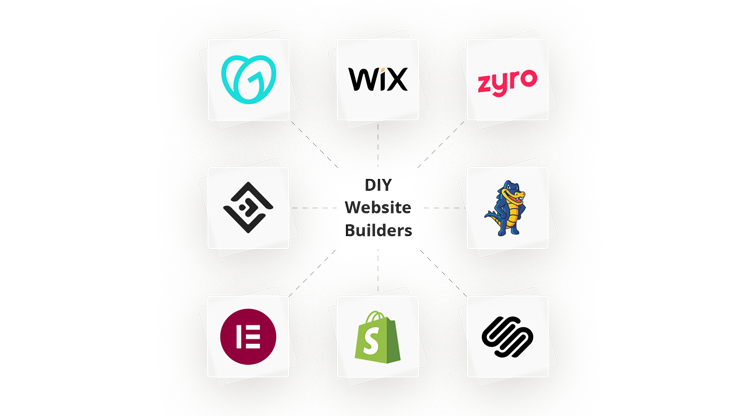With the rise of ecommerce and online shopping, more and more people are finding it increasingly convenient to buy products online. The footwear industry is no different, as this market segment has exploded online and is fast gaining traction with online shoppers, along with becoming a lucrative niche for online sellers.
Consider how, in 2023 alone, revenue from footwear sales is expected to reach over US $398.40 billion, with an annual growth rate of 3.47%. Coupled with the fact that global ecommerce sales reached a massive $6.3 trillion in 2023 and are projected to increase to over $8.1 trillion in 2026, selling shoes online is a lucrative opportunity.
And this is already happening, as selling and reselling shoes online is becoming an increasingly popular way to make money. With some basic know-how of how to sell shoes online, anyone can become a successful entrepreneur!
In this blog post, we will walk you through exactly where and how to sell shoes online so you can hit the ground running and reach financial success.
Let’s understand your goal first
Before jumping directly into how to sell shoes online, it’s crucial to understand your goals first. Each path caters to distinct aspirations, and knowing yours will guide you to the most fitting approach.
Here are two scenarios that can help you answer your question about how to sell shoes online.
Seller type 1: You make shoes and now want to go online
Shoemakers occupy a unique position in the online footwear market. As a shoe designer, having a clear USP and possessing the ability to showcase your craftsmanship directly to worldwide consumers are keys to success.
However, as a shoemaker, you can face many challenges while selling online, such as:
- Demonstrating how your brand differs from other renowned shoe brands in a competitive digital market.
- Ensuring authenticity and brand reputation in the digital sphere is essential, as counterfeit or first-copy shoes can damage your customer’s trust.
- Investing in ecommerce infrastructure and marketing to reach your target audience.
If you can overcome these challenges, there are many opportunities for you to take advantage of in the digital footwear market. Such as:
- You can collaborate with influencers and celebrities to create limited-edition footwear at a premium price and improve your brand recognition.
- You can sell directly to the consumer and eliminate intermediaries to enjoy higher profit margins.
- At the end of every season, you can minimize dead stock by offering discounts to quickly sell your stock to a broader audience.
- You can minimize the cost of maintaining brick-and-mortar outlets.
Recommendation: If you are a shoemaker looking to go online, we recommend choosing option 1 (explained in detail in the next section).
Seller type 2: You want to resell or dropship shoes online
If you’re a shoe reseller who’s currently buying shoes from a shoe vendor or third party (for example, a manufacturer in China) to flip at a higher price or rebrand them to sell online, you’ll probably be responsible for the following:
- Maintaining consistent strategies for sourcing shoes from vendors.
- Managing inventory based on demand fluctuation.
- Maintaining cash flow for viable profit margins based on competitive price changes within the market and from the vendor.
- Making sure customer orders are fulfilled within the expected timeframe.
- Develop and implement marketing strategies to improve your online sales.
In comparison, if you’re a drop shipper who waits for a customer order to arrive before purchasing from a shoe vendor or a related third party, your responsibilities will include:
- Maintaining relationships with shoe suppliers to handle production and shipment.
- Ensuring your shoe suppliers’ quality and regulatory standards to provide high-quality shoes to customers consistently.
- Taking complete responsibility for customer relationship management.
As an online footwear reseller or dropshipper, there are many opportunities for you to take advantage of:
- Worldwide market reach without the hassle of manufacturing shoes yourself.
- Making premium global footwear brands available for your local customers.
- Facilitating footwear manufacturers in expanding to wider markers.
- A loyal recurring customer base that trusts your products.
Recommendation: Whether you’re a shoe dropshipper or reseller, you can leverage a combination of options 1 and 2 (explained in detail in the next section). With option 1, you’ll have your online footwear store where you can build a great brand by branding the shoes you’re sourcing from a third party. With option 2, you can leverage third-party platforms like Amazon and Etsy (benefits explained below).
Option 1: Creating your online store for selling shoes (for all types of sellers)
Making your online store is a powerful and personalized approach to selling shoes. The best part about this option is that it is not exclusive to any particular type of seller.
Reasons to set up your online store
Setting up your online store offers several practical advantages. Here are four key reasons:
1. Brand building opportunity
Your online store becomes a canvas for showcasing your brand’s unique story. With so many options available to the customer, having your space allows you to tell your story, creating a distinctive identity that resonates with customers. This connection goes beyond mere transactions, fostering a sense of trust and recognition.
2. More control over customer relationships
Direct interaction with customers is a significant perk. Unlike selling on external platforms, having your online store enables personal engagement. This connection facilitates understanding customer needs, addressing concerns promptly, and building long-term relationships, all of which are vital to sustaining a thriving business.
3. Lower fees and higher profit margins
Establishing your store means reducing dependency on third-party platforms that often charge fees. With fewer overheads, a larger share of your revenue stays with you. This financial autonomy translates into higher profit margins, providing stability and room for growth.
4. More control and flexibility over marketing/sales channels
Your online store grants you the flexibility to shape your marketing strategies. From social media campaigns to email outreach, you can choose the channels that align with your business goals. This control ensures a more tailored approach to reaching and engaging your audience.
In essence, having your online store is more than a convenience; it’s a strategic move that empowers you to build a brand. This approach positions your business as a unique entity in the digital marketplace, providing a broad range of insight when you’re strategically thinking about how to sell shoes online successfully.
Step-by-step guide to set up an online store for selling shoes
Here’s a comprehensive guide to help you set up an online store:
Step 1: Purchase a domain and hosting service
Start by securing a domain and hosting service. Your domain is your digital address, so choose a name that reflects your brand’s identity and is also easy to remember. Check out our blog post on how to choose a domain name that’s unique and sticks with your brand.
For your hosting service, make sure you choose a reliable service because it’ll ensure your site loads fast, doesn’t suffer from downtime all the time, and is secure. 10Web’s automated WordPress hosting service does exactly this and offers 24/7 live chat support if any issue arises.
Step 2: Research and source your products
Next, conduct thorough research to understand the market and identify your target audience. If you’re making shoes yourself, ensure a steady supply chain for materials.
If curating, source products from reliable suppliers. Quality and uniqueness are paramount, so invest time in finding or creating products that stand out in the competitive shoe market.
Step 3: Choose a website builder and build your shoe store
Your online shoe store’s foundation starts with selecting a suitable website builder. There are multiple options to choose from, with popular options being WordPress, Shopify, and 10Web.
If you ask us, the easiest option would be 10Web because of the unique AI builder tool that takes care of most of the website-building process. It allows you to skip many subsequent steps, offering an encompassing solution from domain hosting to store customization.
Here’s how you can create an ecommerce website using 10Web in 6 simple steps:
1. Go to the 10Web AI Ecommerce Website Builder page. Here, click on the “Generate Your Website” button.
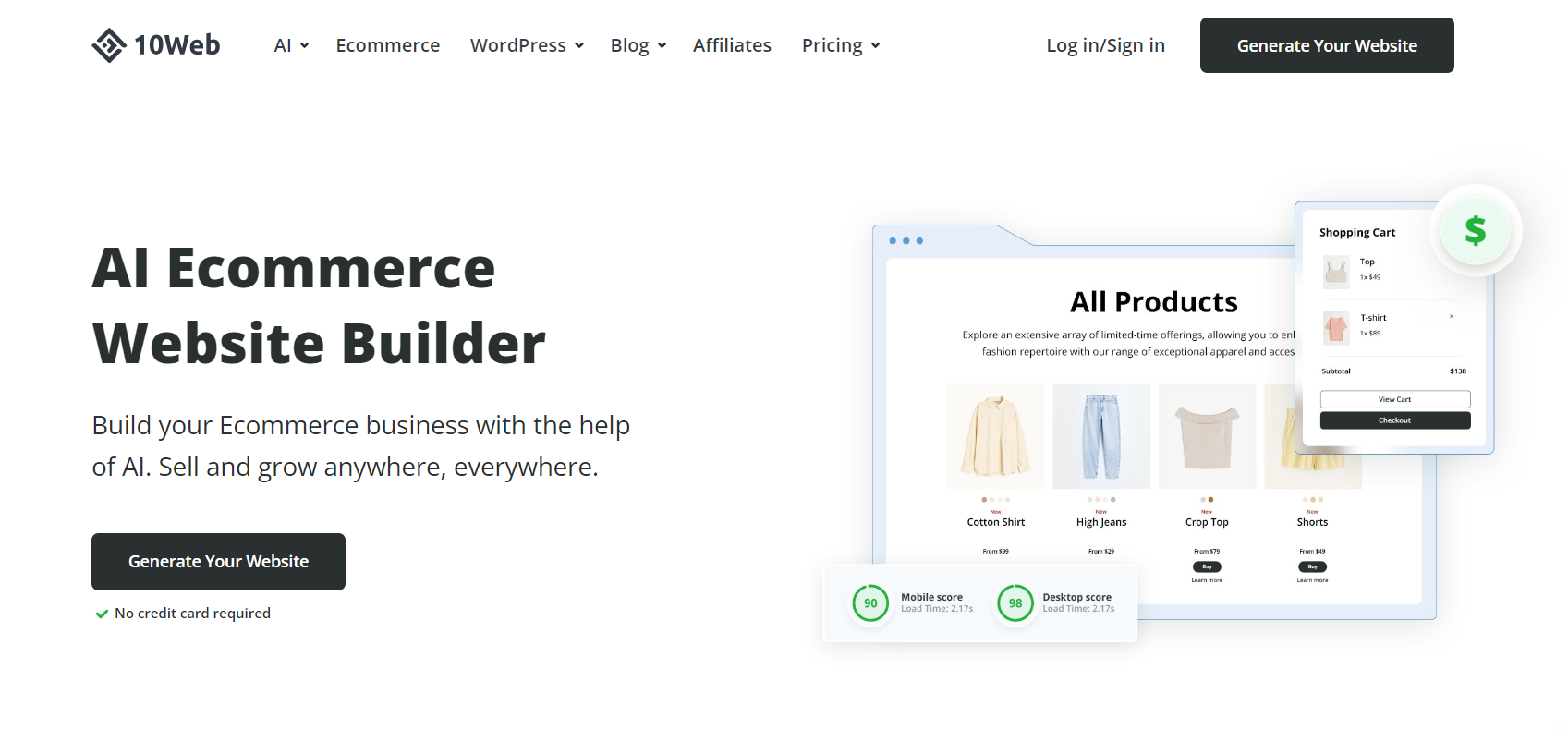
2. Next, choose ‘shoe store’ as the store type.
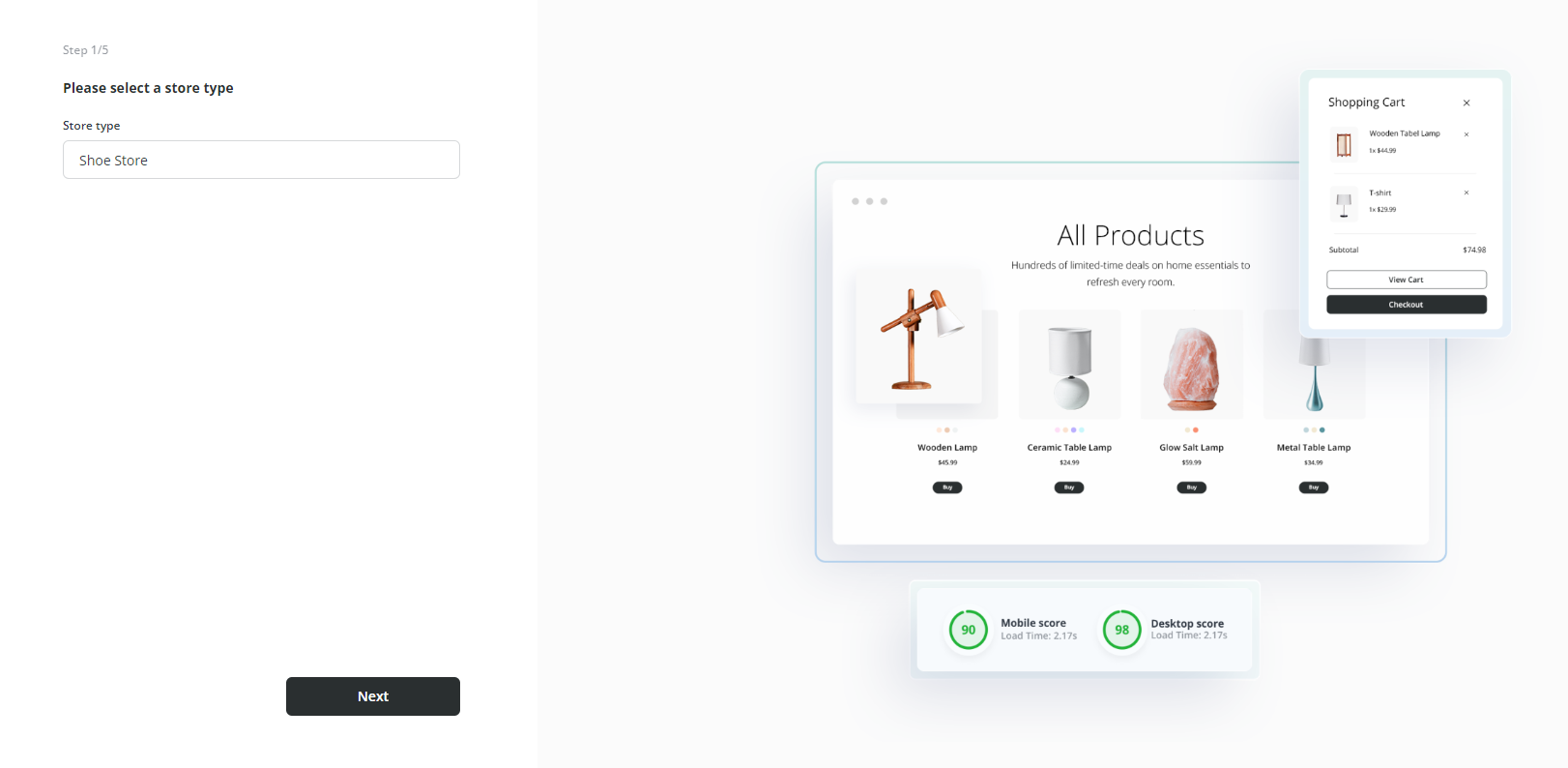
3. Then, write down your store name and provide a brief description of your store that will be highlighted on the homepage of your website. You can even simply write down a rough draft of the text and click “Enhance with AI” to let our AI writing assistant refine the text.
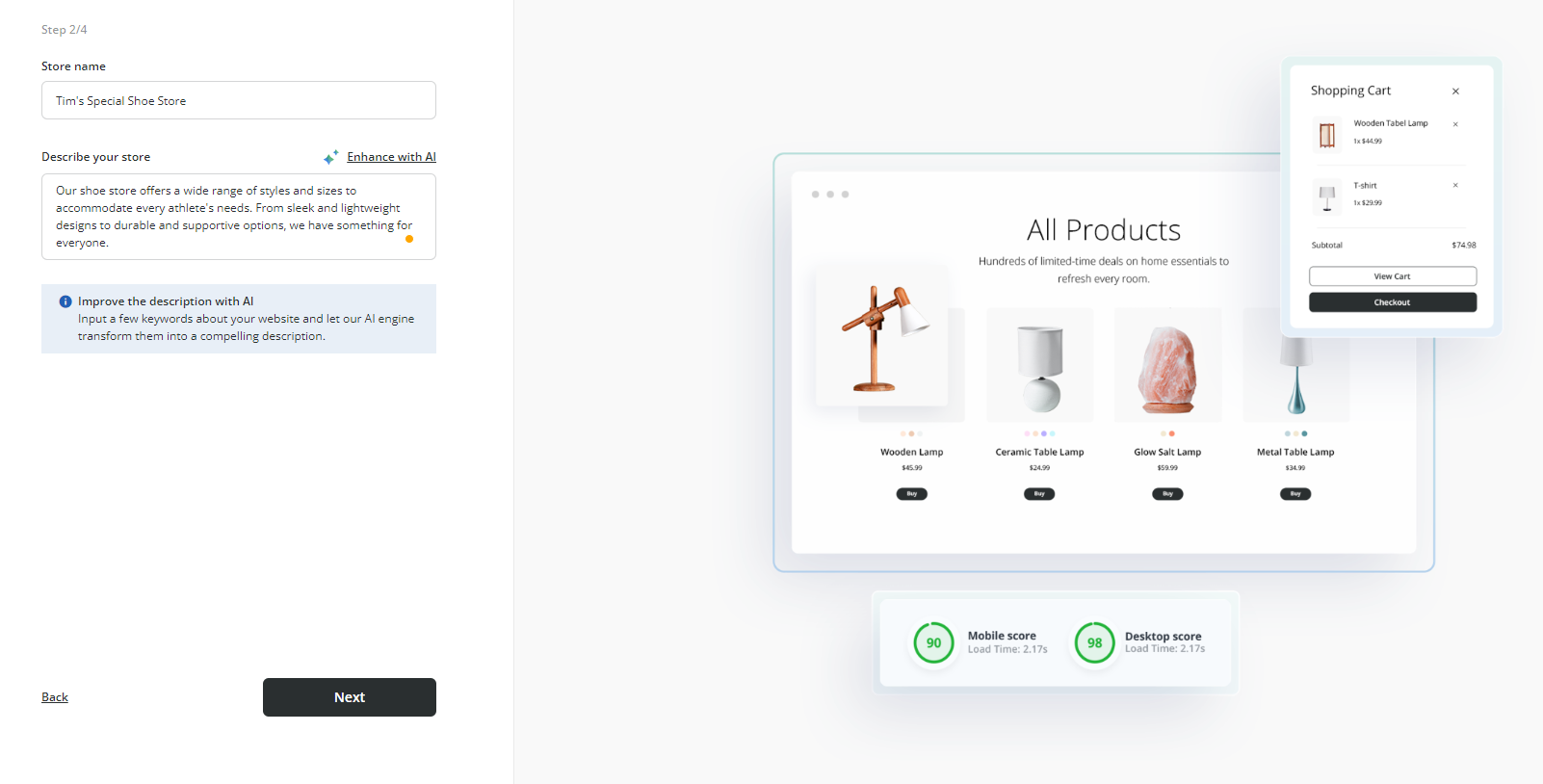
4. Next, add a few products and their category so our tool can start with the relevant product and category pages.
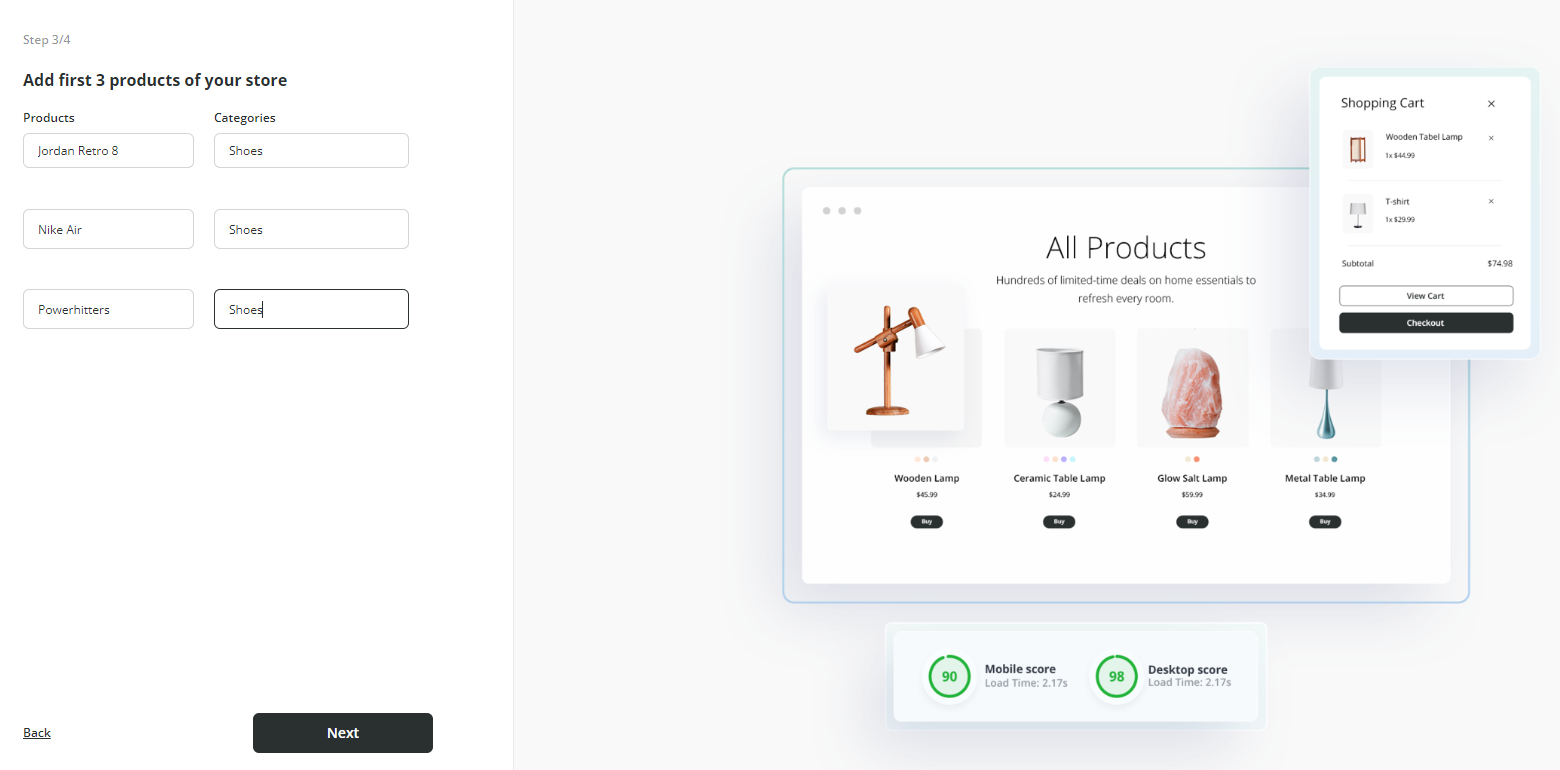
5. Now, choose a tone of voice that aligns with your brand’s identity and let our AI work its magic with the site’s copy.
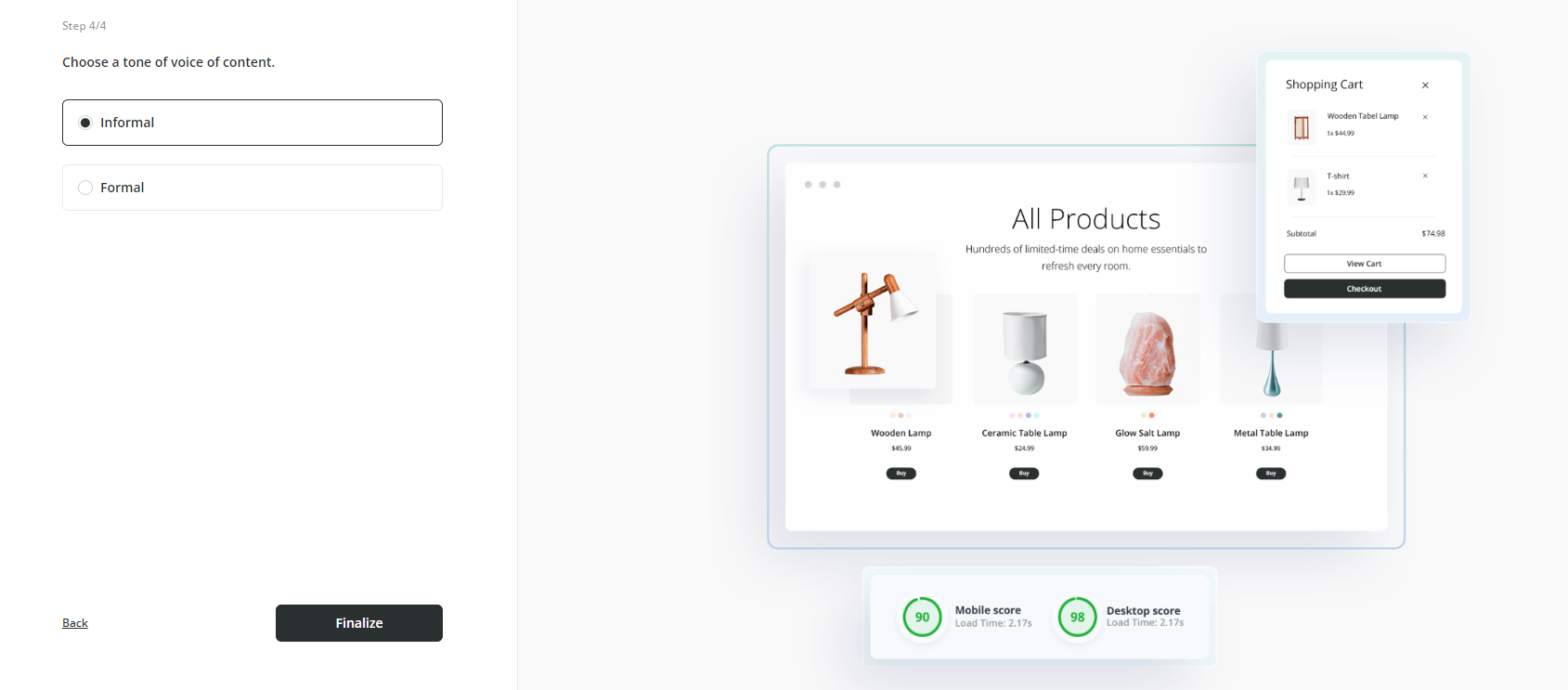
6. Once you click next, our AI Ecommerce Website Builder will work to create your dream digital shoe store. Based on the information provided, you’ll get a stunning preview of a website built by our tool.
And that’s it! From here, you can customize or edit your store and take it live! Our cutting-edge AI Ecommerce Website Builder will help you out with a lot of the store-building process. You can use AI to customize product pages and get AI-generated product descriptions, get AI-generated images wherever you need them on the site.
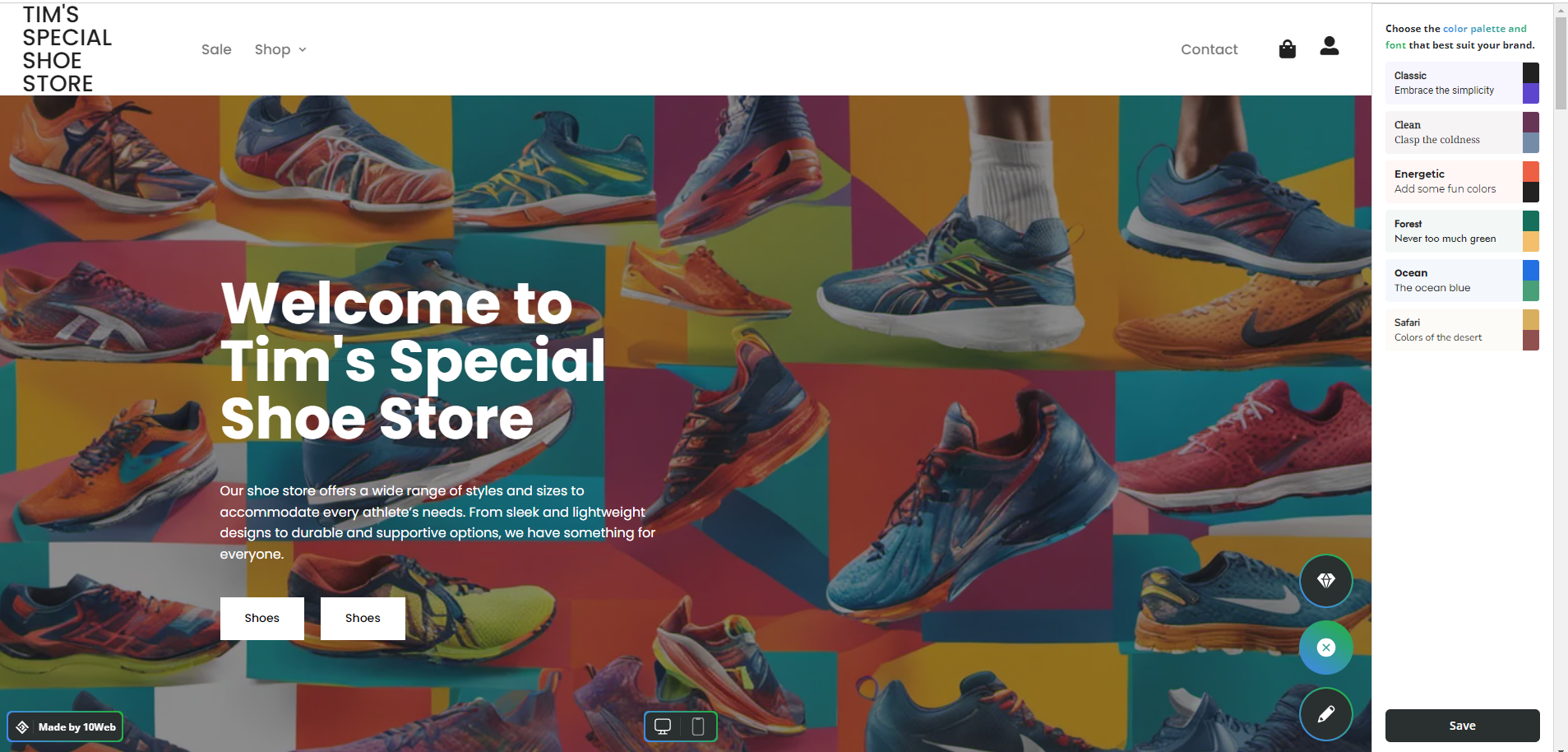
Even after the website is complete, you have advanced features integrated into one place, such as an easy-to-use order and product management system, an analytics tool to analyze customer behavior and preferences, along with providing insights on top-selling products and categories, and so much more!

Looking to sell online?
Create your custom online store in minutes with 10Web AI Ecommerce Website Builder and take your business online.
Step 4: Launch!
With your store constructed and customized, it’s time to introduce it to the world. Before the official launch, conduct thorough testing to ensure a seamless customer experience. Check for website responsiveness, smooth navigation, and secure payment gateways.
Once satisfied, launch your online shoe store with a bang. Announce your arrival on social media, leverage email marketing, and consider promotional offers to generate buzz. The launch is not just a transactional moment; it’s the commencement of your brand’s digital journey.
5 tips to promote and grow your online shoe store
Promoting and growing your online shoe store involves strategic efforts to reach and engage your target audience. Here are five key tips on how to sell shoes online and elevate your digital presence:
1. Leverage social media
Utilize the power of social media platforms like Instagram, Facebook, and Pinterest to showcase your shoe collection. Engage with your audience through visually appealing posts, stories, and reels. You can also use social media to reach an untapped audience that might have yet to be visible if you marketed through traditional means.
2. E-marketing
Implementing effective e-marketing strategies, including email campaigns and newsletters, keeps your audience informed about new arrivals, promotions, and exclusive offers. Build and nurture your email subscriber list to build better communication channels for potential and existing customers.
3. Ensure site optimization for search engines
Ensure that you optimize your shoe store for SEO to enhance its visibility in search results. Conduct keyword research relevant to the shoe industry, implement meta tags, and ensure your product descriptions are rich in SEO-friendly content. This improves the chances of your store being discovered by potential customers.
4. Customer reviews and testimonials
Encourage and prominently display customer reviews and testimonials on your website. Positive feedback builds trust and credibility, influencing potential buyers. Actively seek reviews, respond to customer feedback, and showcase the satisfaction of previous customers to instill confidence in your brand.
5. Discounts and promotions
Offering strategic discounts and promotions can drive traffic to your online store. Consider limited-time offers, seasonal sales, or exclusive promotions for loyal customers. Highlight these discounts prominently on your website and all social media channels to further incentivize purchases.
Incorporating these tips into your marketing strategy creates an engaging online presence for your shoe store. By leveraging both digital and traditional marketing techniques, you can create a well-rounded approach that attracts, retains, and grows your customer base in the competitive online marketplace.
Option 2: Selling shoes in big marketplaces (Amazon, StockX, eBay, etc.) (for all types of sellers)
With the rise of ecommerce marketplaces, entrepreneurs and businesses now have the opportunity to sell their products to a larger audience without needing a physical storefront. How to sell shoes online is not a question anymore with platforms like Amazon and StockX.
These marketplaces have millions of active buyers and offer multiple benefits for all types of sellers, from individual sellers to established brands.
Benefits of selling shoes in big marketplaces
Following are the four benefits of selling shoes in big marketplaces:
1. Established audience
Marketplaces like Amazon and eBay boast vast user bases actively seeking diverse products. Leveraging these platforms grants immediate exposure to a large and diverse audience, potentially increasing sales opportunities.
2. Trust and credibility
Being associated with well-known marketplaces instills trust and credibility among consumers. Buyers often feel more secure purchasing from recognized platforms, contributing to increased conversion rates.
3. Easy setup
Setting up shop on these marketplaces is generally straightforward. The user-friendly interfaces simplify the onboarding process, which is particularly beneficial for sellers who might be new to online retail or seeking answers on how to sell shoes online.
4. Low marketing/advertising costs
Most big marketplaces have built-in marketing strategies and techniques to attract customers. By selling your shoes on these platforms, you can use these marketing efforts without investing in your expensive marketing campaigns.
Drawbacks of selling shoes in big marketplaces
Selling shoes online also has its drawbacks, which include:
1. Platform fees
Marketplaces typically charge fees for listing, transaction, and sometimes, subscription. These fees can cut into profit margins, especially for smaller businesses. Understanding the fee structure is crucial for accurate pricing.
2. Limited brand control
While marketplaces provide visibility, they often limit the level of brand control. Your products exist among numerous others, making it challenging to establish a unique brand identity. Customization options may be restricted.
3. Adjusting to platform policies (and changes)
Adhering to platform policies and adapting to frequent changes can be cumbersome. Policies regarding product listings, shipping, and customer interactions may evolve, requiring sellers to adapt quickly to retain customers.
4. Lack of direct customer relationships
Selling through a marketplace means transactions occur within the platform. This limits direct interaction with customers, hindering the ability to build personal relationships or gather customer data for targeted marketing.
5 best places to sell shoes online
If you’re still wondering how to sell shoes online on different platforms, then here is the list of the five best places where you can showcase and sell online with ease:
Amazon
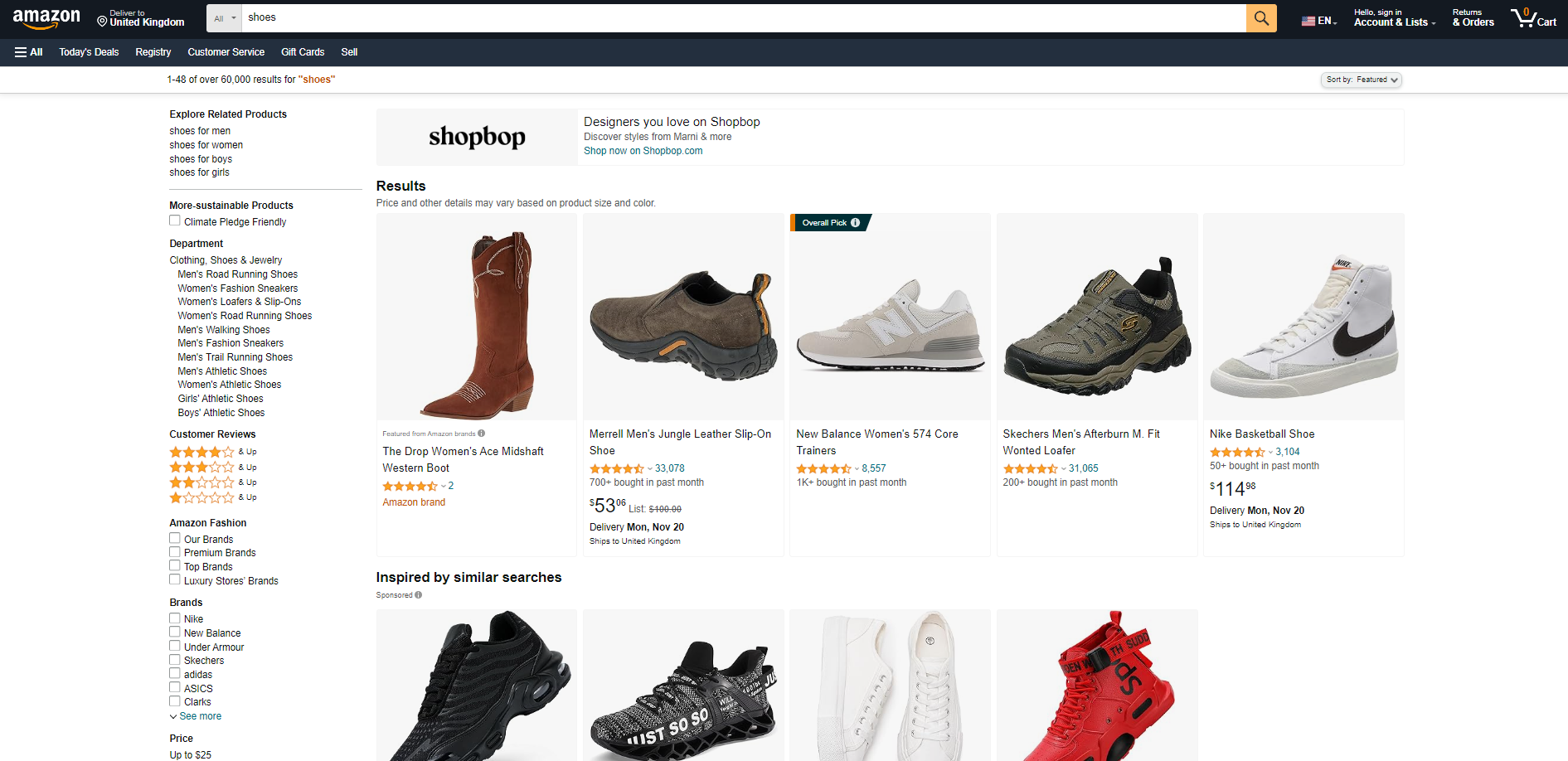
Amazon is the go-to platform for selling shoes online. The trust factor associated with the brand makes it an ideal choice for sellers aiming to build brand loyalty. Its expansive reach and large existing customer base are a great way to reach a large number of potential customers.
StockX
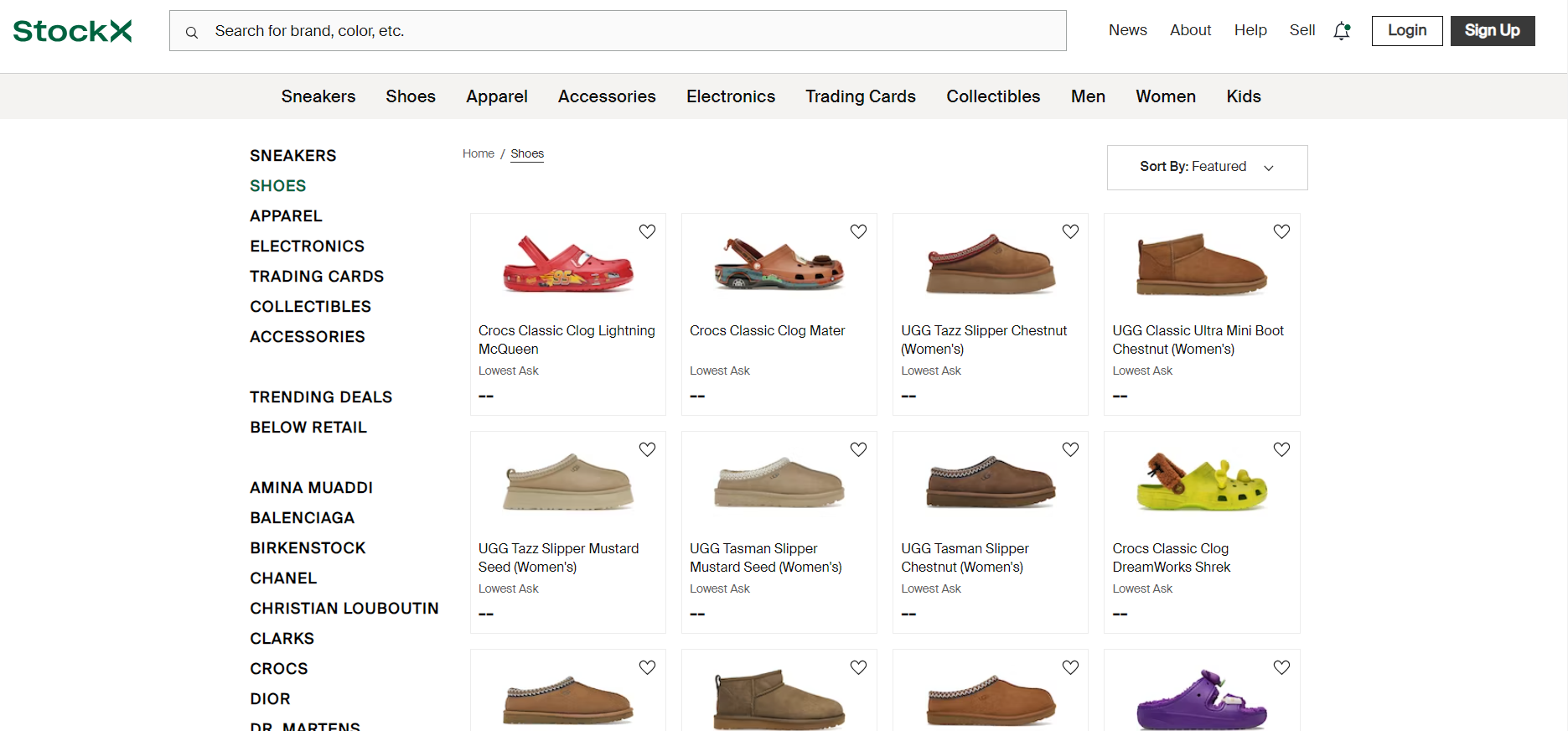
Specializing in sneakers and streetwear, StockX is a marketplace known for authenticity and a transparent resale market. It’s particularly favored for exclusive and limited-edition releases. Users visit StockX because of the diverse range of brands available on the website, ranging from Crocs, Birkenstock, and Nike to Versace, Gucci, Balenciaga, and many more.
eBay
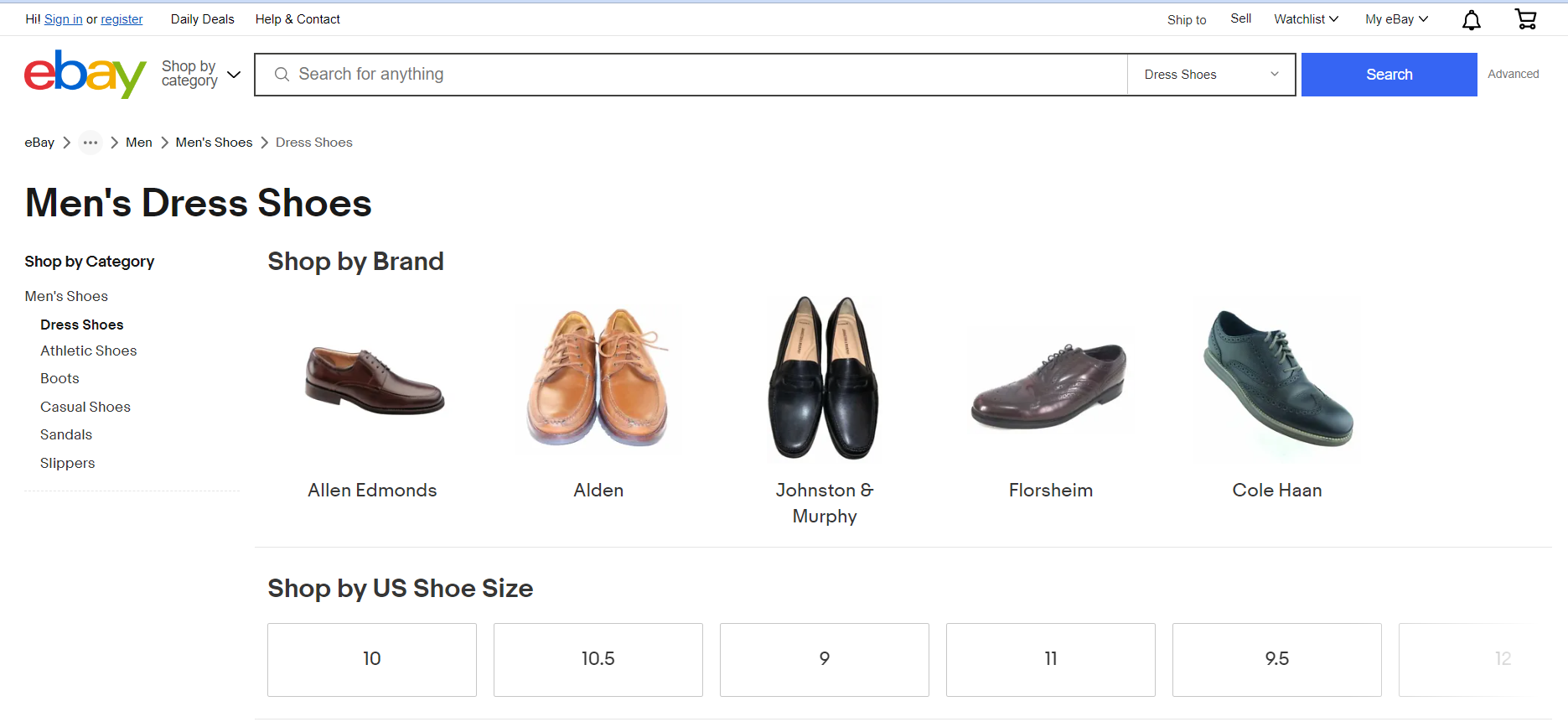
eBay‘s auction-style format and diverse user base make it a versatile platform for selling shoes. It caters to both new and used footwear, appealing to a broad audience. It’s also one of the leading ecommerce stores with the highest customer reach along with competitors such as Amazon.
Etsy
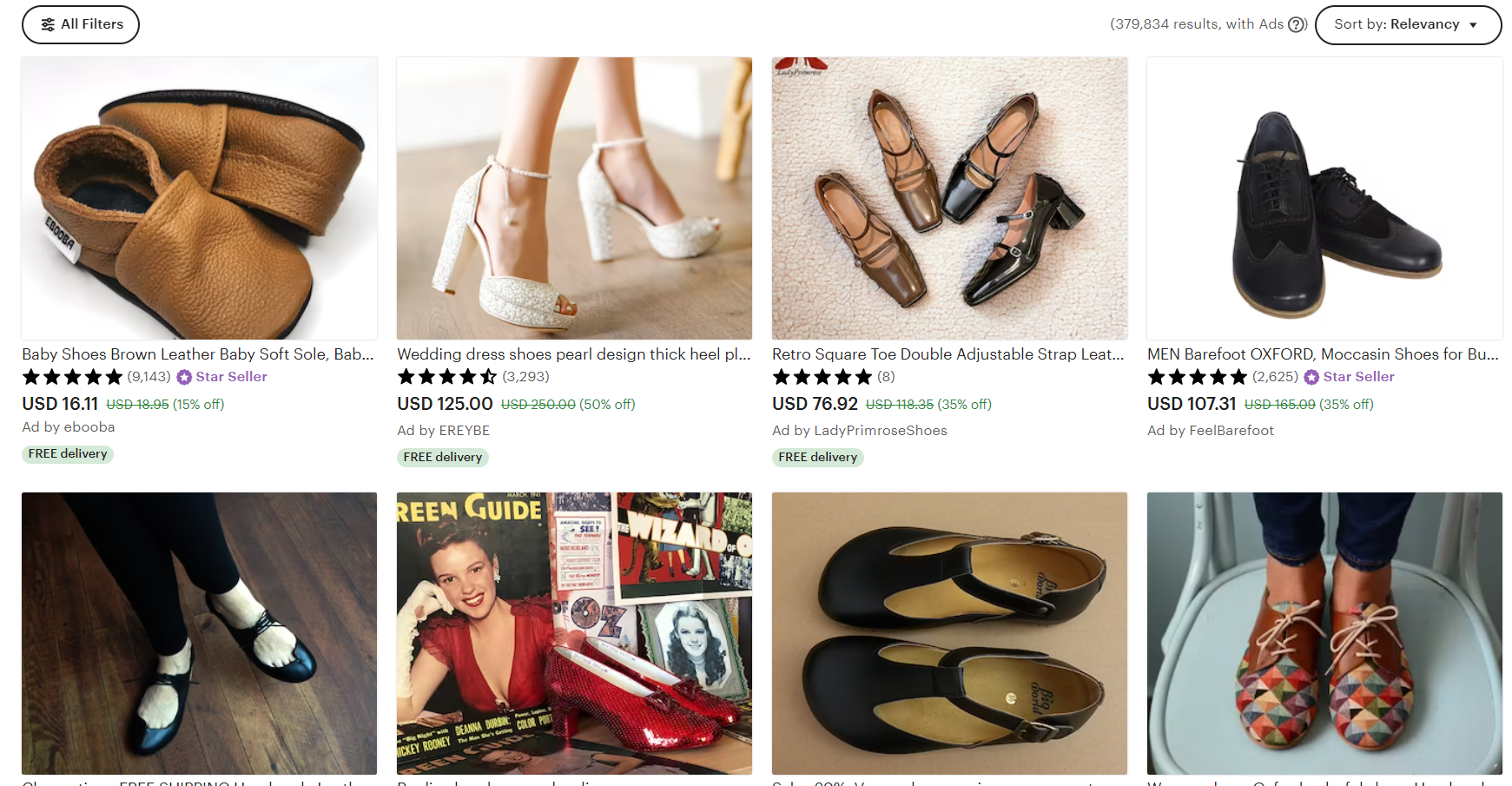
While Etsy is known for handmade and unique items, it has gained traction in the shoe market for custom and artisanal footwear. It’s an excellent platform for niche markets. If you’re a seller who designs unique shoes that are custom-made for a specific audience, Etsy is a great platform to explore.
8 tips to successfully sell shoes in an online marketplace
Here are eight key tips to ensure a successful venture in selling shoes on an online marketplace:
1. Optimize product descriptions for shoe-specific keywords
Enhance the visibility of your shoe listings by incorporating relevant and specific keywords. Consider all important keywords that people searching for footwear will be searching for to optimize your product descriptions.
2. Highlight material and craftsmanship
Communicate the quality of materials and craftsmanship in your shoe descriptions. Detailed information about the materials used and the craftsmanship involved can set your products apart in a competitive marketplace.
3. Use high-quality images and videos
Visual appeal is crucial in the online realm. Showcase your shoes with high-resolution images that capture details from multiple angles. Consider incorporating videos to give potential buyers a more immersive view of your products.
4. Run PPC ad campaigns
Invest in Pay-Per-Click (PPC) advertising to boost the visibility of your shoe listings. Target specific keywords and demographics to reach your desired audience. Regularly monitor and adjust your campaigns based on performance to maximize effectiveness.
5. Be quick to reply to customer queries
Timely responsiveness to customer inquiries is paramount. Address queries promptly and professionally. Swift communication builds trust and demonstrates a commitment to customer satisfaction, positively impacting your seller rating.
6. Provide size and fit information
Clearly state sizing information and offer guidance on the fit of your shoes. Including size charts and fit recommendations helps customers make informed purchasing decisions, reducing the likelihood of returns.
7. Offer competitive pricing and discounts
Research market prices and set competitive yet profitable rates for your shoes. Consider offering occasional discounts or promotions to attract attention and encourage sales. Transparent pricing can build trust with potential buyers.
8. Utilize customer reviews
Encourage customers to leave reviews and testimonials. Positive reviews enhance credibility and build trust among potential buyers. Actively seek feedback and respond to reviews, showcasing your commitment to customer satisfaction.
Option 3: Selling shoes only on social media (as an additional sales channel)
Social media platforms have evolved beyond mere networking spaces — they have become powerful marketplaces. For those pondering how to sell shoes online, an innovative and strategic approach involves exclusive selling through social media platforms.
Benefits of using social media
Selling shoes on social media offers numerous benefits:
1. Low investment, high visibility
One of the primary advantages of selling shoes on social media is the minimum investment required. Establishing and maintaining social media profiles is often free, providing an accessible entry point for businesses of all sizes. Moreover, the potential for high visibility is immense, with billions of active users currently using these online platforms.
2. Easy management
Social media platforms are designed for user-friendly interactions. Managing shoe sales on these platforms is straightforward, with intuitive interfaces and features facilitating product showcasing, communication, and transactions.
3. Direct customer relationships
Selling exclusively on social media allows for direct interaction with customers. This direct engagement fosters community and connection, enabling businesses to understand customer preferences, gather feedback, and build lasting relationships.
4. Visual content sharing
Social media thrives on visual content. Platforms like Instagram, Pinterest, and Facebook are ideal for showcasing the aesthetics of your shoes. Striking images and engaging videos effectively communicate the style, quality, and unique features of your footwear.
Disadvantages of selling only on social media
Although selling only on social media offers numerous benefits, one cannot ignore the drawbacks:
1. Limited functionality
While social media is powerful, it lacks the comprehensive functionality of dedicated ecommerce platforms. Transactional capabilities may be limited, and features like inventory management and order processing may require additional tools.
2. Adherence to platform policies (and changes)
Social media platforms have evolving policies that businesses must adhere to. Navigating and adapting to these policies is essential. Changes in algorithms or policies can impact visibility and reach, requiring businesses to stay agile.
3. Risk of account suspension or ban
Relying solely on social media involves the risk of account suspension or banning. Violating platform policies, receiving negative feedback, or falling victim to algorithm changes could jeopardize your online presence.
4. Limited payment processing options
Social media platforms may have limitations on payment processing options. This restriction could affect the convenience of transactions for both buyers and sellers.
8 strategies to successfully sell shoes on social media
Here are 8 essential tips for selling shoes online effectively on social media:
1. Showcase actual images/videos of the shoe
Bring your shoes to life by showcasing real images and videos. Highlight different angles, details, and how the shoes look in different settings. Authentic visuals provide potential buyers with a genuine feel for your products.
2. Write engaging copy for your posts
Craft compelling and engaging copy that tells a story. Describe the unique features of your shoes, the inspiration behind them, and the benefits they offer. Use a tone that is relevant to your target audience and sparks interest.
3. Leverage platform audience analytics
Use social media analytics tools to understand your audience better. Analyze demographics, preferences, and behavior to tailor your content and marketing strategies. This data-driven approach ensures your efforts align with your audience’s interests.
4. Create contests and giveaways
Keep your audience engaged by organizing contests and giveaways. Encourage participation through likes, shares, and comments. This not only boosts your visibility but also creates a sense of excitement around your brand.

5. Leverage influencer marketing
Collaborate with influencers in the fashion and lifestyle niche. Influencers can authentically showcase your shoes to their followers, tapping into a dedicated audience that values their recommendations. Choose influencers whose style aligns with your brand.
6. Use hashtags strategically
Incorporate trending hashtags in your posts to increase discoverability for relevant search queries. Research popular shoe-related hashtags and those specific to your brand. This widens the reach of your posts to a broader audience.
7. Highlight customer testimonials
Make sure you have positive reviews and testimonials from satisfied customers. This builds trust and credibility, showing potential buyers that others have had positive experiences with your shoes. Feature these testimonials in your posts and stories.
8. Create behind-the-scenes content
If you are a manufacturer, offer a glimpse behind the scenes of your shoe-making process. Share images or videos of the craftsmanship, design, and dedication to creating your footwear. This adds a personal touch and humanizes your brand.
By incorporating these tips into your social media strategy, you can effectively market and sell shoes to your target audience. Social media provides a dynamic platform for connecting with potential buyers, building brand loyalty, and creating a visually compelling narrative for your footwear business.
Related Articles
Conclusion
The online shoe-selling business offers a multitude of opportunities for both creators and resellers. Whether you establish your online store, leverage big marketplaces, or tap into the power of social media, understanding how to sell shoes online is key to a successful venture. Each option holds unique advantages and considerations, from building a brand identity to navigating platform policies.
If you’re considering setting up your online store, don’t forget to check out 10Web AI Website Builder — an all-in-one solution that simplifies the process from website creation to customization, allowing you to focus on what matters most: growing your online shoe business.
Get a head start on website creation with AI
Create a custom website tailored to your business needs 10X faster with 10Web AI Website Builder!
FAQ
How to deliver my shoes internationally?
How much money do I have to have to start an online store for selling shoes?
Can I set up the store on my own, or do I have to hire a developers' team?
How do you sell vintage shoes?
How to sell shoes online as a wholesaler or producer?
- Develop long-term relationships with retailers or distributors interested in bulk purchases.
- Clearly outline your wholesale pricing and terms.
- Create a dedicated section on your online store for wholesale inquiries.
- Utilize B2B ecommerce platforms and attend industry trade shows to connect with potential buyers.
Wait!
Your online store
is a click away
Your online store is a click away
-
Create an ecommerce website in 1 minute with AI
-
Set up and manage payments, products & more
-
Grow your business with all in one platform

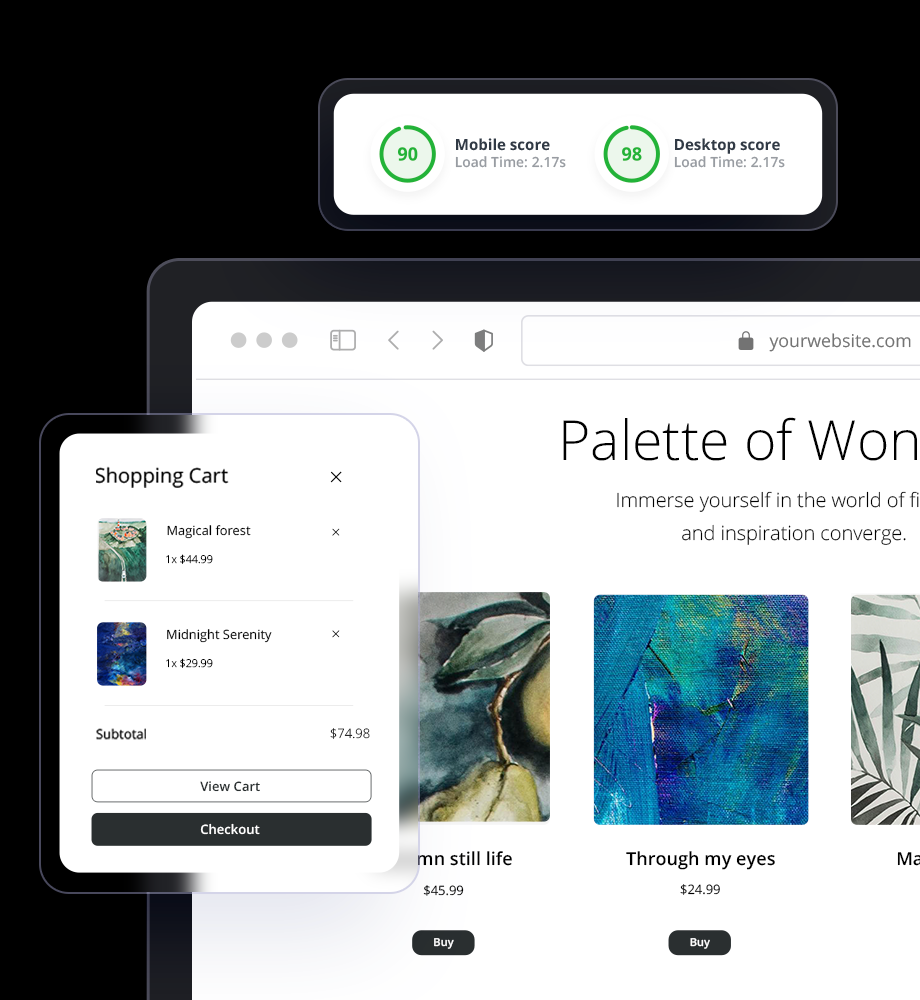





 Create an ecommerce website in 1 minute with AI
Create an ecommerce website in 1 minute with AI 






